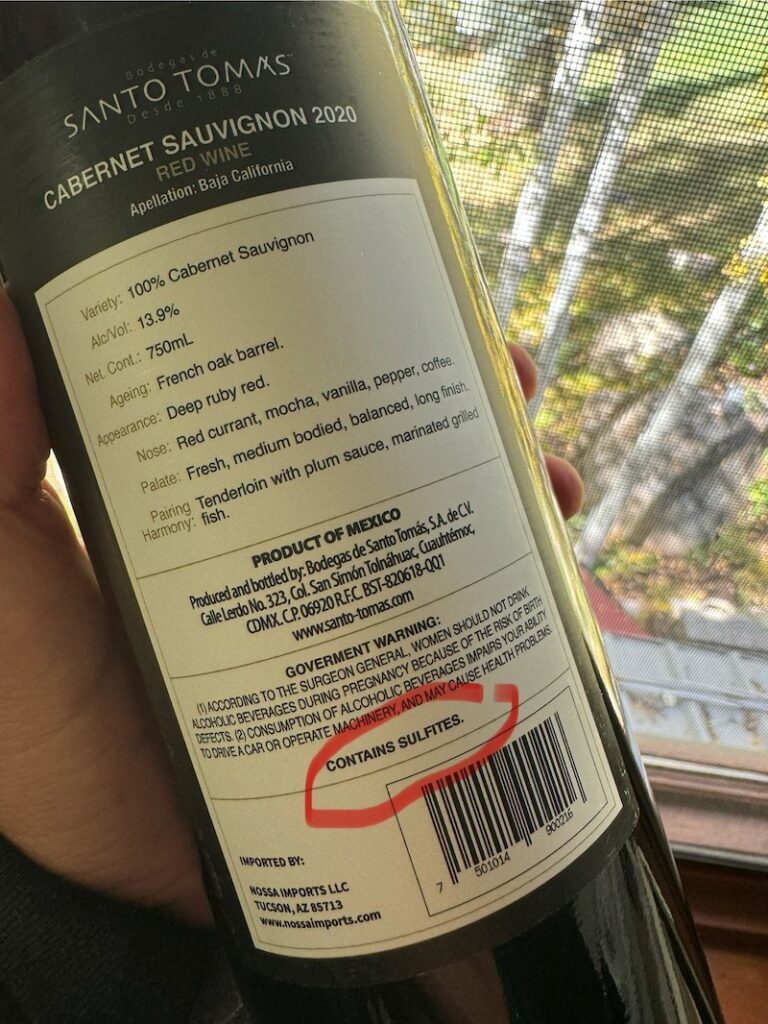It’s time to get a few things straight about sulfites in wine. The truth is low levels of sulfites are naturally present in ALL wine due to the winemaking process; sulfites are a natural byproduct. Some winemakers also deliberately add more sulfites to their wine to protect it from oxidation and microbial contamination during aging/storage. Most actually do. Regardless, ALL wine has some level of sulfites.
The TTB does not permit statements such as “sulfite free,” “free of sulfites,” or “contains no sulfites.” – source
There, I said it! This myth about “sulfite free,” or “free of sulfites” wine is one of my pet peeves and one I had to bite my tongue and nod about at a recent wine tasting when the winemaker himself came out and declared his wine “contained no sulfites.” To avoid being rude and come across as a know-it-all in front of a group of people I had just met, I bit my tongue. But y’all, it was like continuous scaping of fingernails on the chalkboard as he spoke about his “sulfite free” wine. Since I’m supposed to be a know-it-all here, I’m going to set the record straight and pour into the truth about sulfites in wine – what they are, why they matter, which wines have more, and if you should really care.
What are Sulfites?
Sulfites are naturally produced in a variety of foods and drinks. To get a little sciencey without going too deep into high school chemistry, sulfites are a molecule known as sulfur dioxide (so2) – the pairing of sulfur and oxygen. This combo creates an active component that helps preserve some foods, drinks and medications while also inhibiting the growth of fungi and bacteria.
All grapes contain natural levels of sulfur. The sulfites that result in wine are a natural byproduct of the winemaking process. As you might expect, processed and packaged foods often contain added sulfites to help preserve the food. This is where sulfites in wine are misunderstood – in my opinion – and get a bad rap since most winemakers add small amounts of sulfites to their wine. But here’s why…

Why are Sulfites Added to Wine?
On its own, wine is unstable. Adding sulfites to wine helps stabilize and protect it for distribution and to help with preservative for aging…in other words, to keep the wine from oxidizing too early and turning to vinegar. The sulfites essentially capture the oxygen present in the wine and hold it in until the wine is opened, allowing the oxygen to be released. Sulfites also protect the wine since bacteria don’t like them; thus, they are more of an antibacterial for wine.
Adding sulfites to wine is a simple science that has been used for centuries in winemaking and food preservation. Ancient Greeks added sulfur dioxide (SO2) to their wines by lining amphoras with tar to help stabilize the wine for long journeys across the sea. And the Romans would burn sulfur candles in barrels before filling them; the SO2 would then slowly dissolve into the wine.
Most winemakers don’t want to add a lot of sulfites to their wines and will use it sparingly as too much can impact how the wine smells and tastes. But, most do add small amounts to help keep it from oxidizing too early, aka to keep it from turning to vinegar.
There are a growing number of natural wine producers who are trying to differentiate themselves by not adding any sulfites. But, don’t forget the natural yeast in wine produces small amounts of sulfites during the fermentation process. So, ALL WINE naturally has some level of sulfites. Here’s the catch and why they can legally say “No sulfites [sulfur dioxide] detected”. See the word “detected.” The TTB does not permit statements such as “sulfite free,” “free of sulfites,” or “contains no sulfites.”
Then Why do Some Wines Say No Sulfites?
According to the Alcohol and Tobacco Tax and Trade Bureau (TTB), “labels of wines that contain less than 10 ppm of total sulfur dioxide are not required to bear a sulfite declaration. However, we will not approve a label for a wine (other than an agricultural wine) that does not include a sulfite declaration, unless the applicant presents a sulfite analysis conducted by a TTB laboratory establishing that the wine contains less than 10 ppm sulfur dioxide
To translate, all wines have to say they “contain sulfites” unless they go through the TTB sulfite testing to show they contain less than 10 ppm sulfur dioxide. Depending on what the lab results show, a wine may be labeled with the following optional labeling statements.
When the TTB lab report shows less than 10 ppm sulfites:
“Contains less than 10 ppm sulfites”
“Contains less than 10 ppm sulfur dioxide”
When the TTB lab detects no sulfites:
“No sulfites [sulfur dioxide] detected”
“No detectable sulfites [sulfur dioxide]”
The TTB does not permit statements such as “sulfite free,” “free of sulfites,” or “contains no sulfites.”
Are Sulfites Bad for You?
If you have a sulfite allergy, yes. Asthma, maybe. Everyone else, no.
There is currently no reliable allergy testing available for sulfites; you simply have to find out the hard way. The good news is, according to the FDA, 1 in 100 people are sensitive to sulfites and only one percent of people have a true sulfite allergy. If you are in that one percent, I’m sooo sorry. If you think you are one of them, can you eat a dried apricot or a pickle without your throat closing up? If so, I’m not talking to you…and again sorry, that sucks if you are in that one percent.
If you have asthma, sipping wine might give you a reaction due to the histamines and sulfites. A medical study found around 1 in 3 people with asthma said alcohol triggered their symptoms. For those with asthma, the best way to check your sensitivity level is to sip a small amount to see your reaction. I suggest having someone not sipping be with you in case you need to get medical attention, and don’t overdo your sipping. You might also want to start with light, a red wine from France versuses a big cab from the United States. I’ve found they have less histamines and the highly regulated growing process in France doesn’t allow pesticides.
Now, to the rest of the 99 percent of you, let’s get straight on to sulfites in wine.
People blame sulfites for giving them headaches. Science hasn’t proved this yet, and given that sulfites naturally occur in so many other things—dried fruit, orange juice, pickles—it’s not the sulfites. It could be that you just drank too much wine. If you can sip white wine without any issues but get a headache within a few sips of red wine, it’s not the sulfites. White wine has more sulfites than red wine. It’s likely the histamines in your red wine. Try taking a Zyrtec or other non-drowsy allergy pill to see if that changes the game.
Selecting Wines Based on Sulfites
White wines have higher levels of added sulfites to stabilize the wine. Red wines have tannins which are polyphenols from the stems, skin, and seeds of grapes, and are naturally-occurring preservatives, which reduces the need for adding sulfites.
Mass-produced, distributed wines tend to have more added sulfites since they need to have a longer shelf life and need to travel further. Look for smaller, less distributed wines – boutique, local wineries – as they won’t need to have as many sulfites added.
Sweet wines have the most sulfites added to prevent the yeast and extra sugar in the wines from triggering a secondary fermentation.
Wines without added sulfites have a shorter shelf-life, in other words they won’t age as long or as well. If you’re buying wines without added sulfites, drink them young.

